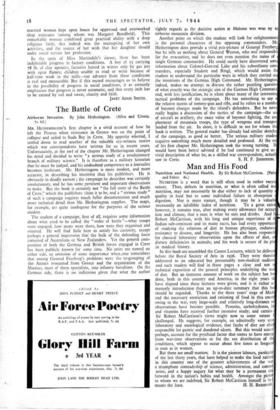The Battle of Crete
MR. HETHERINGTON'S first chapter is a vivid account of how he left the Piraeus when resistance in Greece was on the point of collapse and sailed to Suda Bay in Crete. My appetite whetted, I settled down to read another of the valuable eye-witness stories which war correspondents have written for us in recent years. Unfortunately, at the end of the chapter Mr. Hetherington changed his mind and decided to write "a serious study of a revolutionary branch of military science." It is therefore as a military historian that he must be judged, and his undoubted competence as a journalist becomes irrelevant. Mr. Hetherington is more modest, and more accurate, in describing his intention than his publishers. He it obviously in deadly earnest ; the campaign he describes was certainly revolutionary, and he has some pertinent and important observations to make. But the book is certainly not "the full story of the Battle of Crete," which the publishers claim it to be, and a " serious study" of such a campaign requires much fuller documentation and much more technical detail than Mr. Hetherington supplies. The maps, for example, are quite inadequate for the purposes of the serious student.
The student of a campaign, first of all, requires some information about what used to be called the "order of battle "—what troops were engaged, how many were there, how were they organised and situated. He will find little here to satisfy his. curiosity, except perhaps a general impression that the bulk of the defending force consisted of Australians or New Zealanders. Yet the general com- position of both the German and British forces engaged in Crete has been publicly known for some time. No units are named on either side, an omission of some importance when.one remembers that among General Freyberg's problems were the re-grouping of the Anzacs evacuated from Greece and the organisation of the Marines, most of them specialists, into infantry battalions. On the German side, there is no indication given that what the author rightly regards as the decisive action at Maleme was won by airborne mountain division.
Another point on which the student will look for enlightenme is the personal characters of the opposing commanders. Mr Hetherington does provide a vivid pen-picture of General Freyber but he tells us nothing about General Weston, who was' responsibl for the evacuation, and he does not even mention the name of single German commander. He could surely have discovered sons information about Colonel-General Lohr and his subordinate corn manders, especially Student and Ringl, which would assist th student to understand the particular ways in which they carried o the intentions of the German High Command. Mr. Hetheringto indeed, makes no attempt to discuss the rather puzzling questio of what exactly was the strategic aim of the German High Conunan and, with less justification, he is silent about many of the interes tactical problems of the campaign. He has something to say the relative merits of torrimy-gun and rifle, and he refers to a numb of bayonet charges made by the island's defenders. But he nev really begins a discussion of the tactics of the campaign—the u of aircraft as artillery, the exact value of bayonet fighting, the em ployment of mountain troops, the type of weapons and transpo landed from the air. In short, it is difficult to see for whom th book is written. The general reader has already had similar sketch of the campaign, as good or better. The serious military stude requires something much more detailed and profound. At the en of his first chapter Mr. Hetherington took the wrong turning: would have been better advised if he had continued to give us vivid description of what he, as a skilled war correspondent, actua


























 Previous page
Previous page